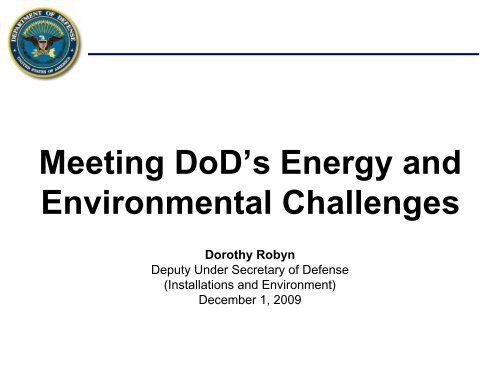Presentation - SERDP-ESTCP
Presentation - SERDP-ESTCP
Presentation - SERDP-ESTCP
Create successful ePaper yourself
Turn your PDF publications into a flip-book with our unique Google optimized e-Paper software.
Meeting DoD’s Energy andEnvironmental ChallengesDorothy RobynDeputy Under Secretary of Defense(Installations and Environment)December 1, 2009
Combat Power Begins At HomeAcquisition, Technology and LogisticsOverall DoD MissionOverall DoD SupportFunctionsDeputy Under Secretary ofDefense (Installations& Environment) Mission:Provide the military forces needed to deter war and to protect the securityof the United StatesEnsure that the Department rapidly delivers the right capabilities,resources and materiel to our warfighters - what they need, where theyneed it, when they need it, anywhere in the worldProvide installation assets and services necessary to support our militaryforces in a cost effective, safe, sustainable, and environmentally soundmannerIt is the policy of the United States to promote the efficient and economical use of America's realproperty assets and to assure management accountability for implementing Federal real propertymanagement reformExecutive Order 13327
Real Property in theU.S. Department of Defense (DoD) EnterpriseAcquisition, Technology and LogisticsDoD, like virtually allcustomer-centric businesses,is an enterprise.• More than 539,000 real propertyassets with plant replacementvalue of $700B+• More than 5,500 sites in the USand 40 other countries• Expenditures of $62B+/year forsupporting our Installations andEnvironment programs• Almost 300 different installationmanagement systems
The sound youAcquisition, Technology and Logisticsdon’t hear is usdoing our jobs…DoD Explosives Safety BoardEnabling the DoD Mission byOperationalizing Explosives Safety6
Key PointsAcquisition, Technology and Logistics• Energy and the environment are a high priorityto DoD — and that reflects self interest• Science and technology are key to DoDprotecting the environment and reducing itscarbon “bootprint”• It’s critical to get the incentives right
I. Energy and the environment are a high priority to DoD — andthat reflects self interest
Executive Order 13514“Federal Leadership in Environmental, Energy andEconomic Performance”Acquisition, Technology and Logistics• Gives federal agencies 90 days to set 2020 greenhouse gas (GHG)reduction goal• Sets targets for sustainable buildings water efficiency, wastereduction• Expands green procurement ($500B/year in purchasing power)
DoD Energy UseAcquisition, Technology and Logistics• $20B direct costs in 2008– $16B fuelo Current optempo higho Fuel price high– $4B facilitieso 64% electricity purchases• Energy GHG Emission– 73.5 million MT CO 2 eq in 2008o 1.3% of US emissionso Would be in top 40 countriesGHG (CO 2 eq)Facility (36%)Mobility & generators (62%)Fleet fuel: non-tactical (2%)
Army Energy GHG EmissionsAcquisition, Technology and LogisticsFuture footprint?(CO 2e )Current Optempo(CO 2e )Facilities (77%)Generators (2%)Combat Aircraft (10%)Tactical Vehicles (5%)Non-tactical Vehicles (5%)Facilities (50%)Generators (17%)Combat Aircraft (15%)Tactical Vehicles (16%)Non-tactical Vehicles (2%)
North
Lowest-Hanging Fruit:Energy Efficiency ImprovementsAcquisition, Technology and Logistics• Buildingstandards• HVACsystems• Metering
DoD as a Steward of the EnvironmentAcquisition, Technology and Logistics• 29 million acres– 17 million of themwithdrawn from the Bureauof Land Management• Pristine test and trainingranges• More than 320 threatenedand endangered species
II. Science and technology are key to DoD protecting theenvironment and reducing its carbon “bootprint”
DoD Built InfrastructureAcquisition, Technology and Logistics• 539,000 Facilities(buildings, structures,linear structures)– 307,295 buildingso 2.2 B sq ft• Comparisons– GSA: 1,513 governmentbuildingso 176 M sq ft– Walmart US: 4,200buildingso 687 M sq ftOperation & Training (10%)Maintenance & Production (14%)Research, Development, Test, and Evaluation (3%)Supply (15%)Hospital & Medical (3%)Administrative (10%)Family Housing (20%)Troop Housing and Mess Facilities (12%)Community Facilities (11%)Utility & Ground Improvements (1%)
Current PracticeAcquisition, Technology and Logistics• Very little research and development directed towardinstallation energy issues• Exploitation and leveraging of Department of Energy(DOE) investments uncoordinated and limited• Current practices sub-optimal in all phases– Design, build, commission, and operate– Current reduction in energy usage outpaced by increase inenergy costso Air Force reduced energy usage by 11% but costs increased by49% (2001 to 2007)• Technology Procured Though Alternative FinancingMechanisms: ESPC and UESC– Barrier to exploiting innovation• Unique opportunity being missed
Energy IntensityAcquisition, Technology and Logistics• DoD Energy intensity (2008): 327 KW-hr/m 2• Next generation buildings ~ 75 to 150 KWhr/m 2US Commercial Buildings vs. DoDKW-hr/m 27006005004003002001000Offices (2003)Health Care (2003)Lodging (2003)Warehouse (2003)DoD 2003DoD 2008
Installation Energy R&D InitiativeAcquisition, Technology and Logistics• Use DoD facilities as test bed for innovative energy technologies– Validate performance, cost, and environmental impacts– Transfer lessons learned, design and procurement information acrossall Services and installations– Directly reach out to private sector for innovations– Leverage DOE investments• Test and evaluate for all DoD facilities– Energy conservation and efficiency– Renewable and distributed energy generation– Control and management of energy resources and loads• Stimulate increased investments at DoD facilities (Energy SavingsPerformance Contracts)• Transform DoD’s military construction design practices
BenefitsAcquisition, Technology and Logistics• Decreased Costs and Increased Security– Reduced energy demand in existing buildings ~50%– Reduced energy demand in new buildings ~80%o Through systems design, modeling, and monitoring coupled to energyefficient components– Increased energy efficiency and power qualityo Distributed energy resources (DER)o Micro-grid management– Increased fuel diversity and reduced price volatilityo DER and renewables– Increased securityo Local power generation and reduced demando Islanding through micro-grid management• Reduced Carbon Footprint (CO 2 )
North
III. It’s critical to get the incentives right
















